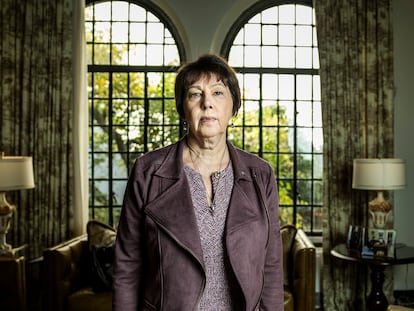NASA executive Leslie Livesay: ‘We’re getting closer to being able to answer if there is life beyond Earth’
The US space agency is finalizing the launch of a new telescope to explore planets beyond the Solar System

Leslie Livesay is deputy director of NASA’s Jet Propulsion Laboratory (JPL), the research center where the largest robotic space missions carried out by the U.S. space agency are designed. During her nearly 40 years of experience at NASA, this mathematician and engineer has seen the potential of space probes grow from timid Martian cars, such as the Pathfinder of 1996, to the Perseverance of 2018, the largest and most sophisticated vehicle in history for exploring the red planet.
One of the scientist’s main objectives in her new position will be to oversee an even more difficult task: to bring samples from Mars back to Earth before its biggest competitor does: China, a country with which the U.S. is also competing for the exploration of the Moon. In this conversation with EL PAÍS, during her recent visit to Spain, Livesay reviews what NASA’s large unmanned space missions will be like, some of which will be essential for astronauts to be able to reach the Moon and Mars later on.
Question. What is the biggest question about the universe?
Answer. For me it’s: are we alone? Is there life somewhere else? We’re getting closer and closer to being able to answer that, and our technology is getting better. We just launched the Europa Clipper mission. It’s not specifically designed to look for life, but we know that on this moon of Jupiter there’s a saltwater ocean beneath the surface that’s twice the size of the entire oceans on Earth, and it could support life. So we’re going there to investigate whether it has the right composition and structure, whether all the things we would need for life to exist are present.
Q. Until recently, Europa was not a priority in the search for life. Now it has become one of the leading candidates for hosting it; more so than Mars, for example.
A. Yes, that’s true. Although we just collected a very interesting sample from Mars and we’re looking forward to bringing it back with a new mission, the Mars Sample Return. In 2026, we’re going to launch the Roman space telescope, which will carry a coronagraph that will allow us to observe exoplanets directly, because we’ll be able to block the light coming from their star. We’re putting together a lot of pieces of the Solar System puzzle; it’s a great time for space research.
Q. When will the Mars Sample Return take place?
A. We expect by the mid- to late-2030s.
Q. What other great mission lies ahead for you?
A. I would say our involvement in the Habitable Worlds Observatory, our next big astrophysics mission, which we’re doing with the Ballard Space Flight Center. [It will be the first telescope developed to search for life on planets beyond the solar system.] On the other hand, Earth science is becoming increasingly important. We’re seeing the Earth change faster and faster, as evidenced by the tornadoes that hit Florida recently and affected the launch of Clipper. It’s time to study the planet better, to make sure that policymakers have all the information they need to make decisions.
Q. The United States and its partners, including Europe, are planning to send astronauts to the Moon after 50 years. One of the goals is to study the Moon’s resources, water and other minerals. This is also being pursued by China and India. Do you think there is a risk that the Moon will become a lawless land for space exploration?
A. We are partners with India. Since the time of the Apollo missions, we have used robotic missions. There are a lot of things we can do with other countries on the Moon. And the Moon is certainly our intermediate station to reach Mars, which is much more difficult.
Q. What types of robots will we see on future missions to the Moon, Mars, and other destinations?
A. We need a robot capable of drilling through the ice and reaching the ocean of Europa, for example. We are developing it. On Mars, our capacity has increased enormously: compare the first vehicle that arrived in 1997 with Mars 2020. It’s amazing. The capacity for analysis is spectacular. The same will happen with the robots that are sent to the Moon and other places, because our objective is for humans to be exposed as little as possible. We’ve launched the first helicopter on another planet, Ingenuity. And we have something similar, Dragonfly, which we are going to send to Titan, Saturn’s moon. Robotic missions have a huge horizon ahead of them; we will be the first to arrive and we will lay the foundations for human exploration.
Q. How do you expect to drill through the ice?
A. The first thing we need to figure out is how thick the ice sheet is on Europa. Clipper carries radar that will allow us to study it and think about the technologies we could use. We've been studying how to do this for years and we don't really have a clear solution yet.
Q. Why did you come to visit Spain?
A. This year we renewed the agreement between NASA and Spain, a significant milestone for the future of the Madrid Deep Space Network Station. We are celebrating its 60th anniversary. This station plays a crucial role and supports communications with spacecraft exploring the outer reaches of our Solar System and beyond.
Recently, the Madrid station demonstrated its critical importance when its six antennas were used in an advanced array configuration. This allowed us to communicate with the Voyager 1 spacecraft and perform a historic software upgrade. For the first time since launch, we had to reprogram the spacecraft to avoid a faulty memory section. The success of this operation highlights the station’s vital role in deep space exploration and its promising future in supporting NASA’s most ambitious missions.
Sign up for our weekly newsletter to get more English-language news coverage from EL PAÍS USA Edition
Tu suscripción se está usando en otro dispositivo
¿Quieres añadir otro usuario a tu suscripción?
Si continúas leyendo en este dispositivo, no se podrá leer en el otro.
FlechaTu suscripción se está usando en otro dispositivo y solo puedes acceder a EL PAÍS desde un dispositivo a la vez.
Si quieres compartir tu cuenta, cambia tu suscripción a la modalidad Premium, así podrás añadir otro usuario. Cada uno accederá con su propia cuenta de email, lo que os permitirá personalizar vuestra experiencia en EL PAÍS.
¿Tienes una suscripción de empresa? Accede aquí para contratar más cuentas.
En el caso de no saber quién está usando tu cuenta, te recomendamos cambiar tu contraseña aquí.
Si decides continuar compartiendo tu cuenta, este mensaje se mostrará en tu dispositivo y en el de la otra persona que está usando tu cuenta de forma indefinida, afectando a tu experiencia de lectura. Puedes consultar aquí los términos y condiciones de la suscripción digital.
More information
Archived In
Últimas noticias
Most viewed
- Reinhard Genzel, Nobel laureate in physics: ‘One-minute videos will never give you the truth’
- Oona Chaplin: ‘I told James Cameron that I was living in a treehouse and starting a permaculture project with a friend’
- Pablo Escobar’s hippos: A serious environmental problem, 40 years on
- Why we lost the habit of sleeping in two segments and how that changed our sense of time
- Charles Dubouloz, mountaineering star, retires at 36 with a farewell tour inspired by Walter Bonatti










































